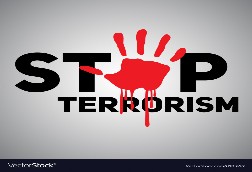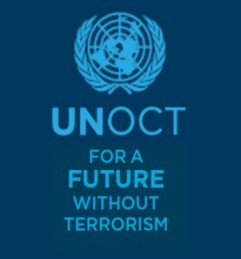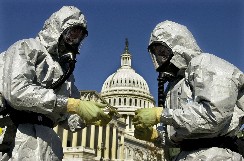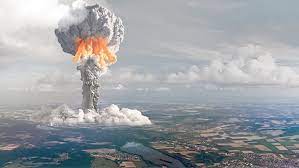| ||||||||||||||||||||||||||||||||||||||||||||||||||||||||||||||||||||||||||||||||||||||||||||||||||||||||||||||||||||||||||||||||
|
|
| |||||||||||||||||||||||||||||||||||||||||||||||||||||||||||||||||||||||||||||||||||||||||||||||||||||||||||||||||||||||||||||||
|
ТЕМА 10. Противодействие терроризму/экстремизмуUnit 10
Combating Terrorism / Extremism
The threat of terrorism has increased over the last years. Few parts of the world have remained untouched by the wave of terrorism. Before а discussion of terrorism is possible, it is necessary to understand the meaning of the word “terrorism”. There are over 100 different definitions of terrorism. But more often terrorism is defined as the use of violence (including murder, hostage taking, hijacking and bombings) to intimidate innocent civilians and achieve political, ideological or religious purposes. The main features of terrorism are: the effect of extreme fear, its targets, its strategic goals, etc. There are different types of terrorism. They are often connected with the causes motivating terrorism, including: independence or separatist movements, environmental protection (eco-terrorism), spread of a particular religion (religious terrorism) and so on. The perpetrators of acts of terrorism can be individuals, groups, or even states. Terrorist groups usually methodically plan attacks in advance, and may train participants and raise money from supporters or through organized crime. Various personal and social factors may influence the personal choice of whether to join a terrorist group or commit an act of terrorism, including: affiliation with a particular culture, ethnicity, or religion, financial gain, mental illness, social isolation, etc. Terrorist attacks are often aimed to maximize fear and publicity, very often using explosives or other weapons of mass destruction, mass casualty and mass disruption. The goal of terrorism is to destroy the citizens’ feeling of security in the places most familiar or important to them. The hope of terrorists is that the sense of terror will force the population to pressure political leaders toward a specific political end. Terrorist acts often include hijackings, hostage takings, kidnappings, mass shootings, car bombings, suicide bombings, etc. Victims and locations of terrorist attacks often are carefully selected for their shock value. Schools, shopping centers, bus and train stations, and restaurants and nightclubs are often targeted. Major targets sometimes include locations that are important economic or political symbols, such as embassies or government buildings. Terrorism is а complex problem. It is a global fight, which requires a global system to defeat it. Countries-members of various international organizations unite their efforts to combat terrorism. In the framework of international cooperation in combating terrorism, the Republic of Belarus is a party to all major universal legal instruments in this field. Belarus is constantly working to improve national legislation, policies and practices in the field of combating terrorism. Terrorism is not the same as extremism, though sometimes it is really difficult to draw the line between them. Extremism is the vocal or active opposition to fundamental values, including democracy, the rule of law, norms of the state and the existing social order, individual liberty and respect and tolerance for different faiths and beliefs. Extremist groups often use Internet and social media to target people. Both terrorism and extremism are usually linked to political, social\ or religious beliefs and ideas, that’s why some researches consider extremism to be the ideological “umbrella” for terrorist organizations. The main difference between terrorism and extremism is that extremism is linked to thought and terrorism is linked to action. Extremists don’t commit terrorist or violent acts, though they often pose particular threats, both online and offline.
A
Exercise 1. Give the English for: Международное сообщество, международные конвенции ООН, предупреждение терроризма, угроза терроризма, акт терроризма, распространяться по миру, определение терроризма, насилие, применение насилия, запугивать население, политические или идеологические цели, форма насилия, невинные граждане, военизированные группировки, законный, террористическое движение, политическое давление, внимание средств массовой информации, бороться с терроризмом, разрабатывать стратегию, сотрудничество между странами.
Exercise 2. Match English and Russian equivalents:
Exercise 3. Complete the sentences: 1) Terrorism is … 2) The League of Nations developed the Convention for the Prevention and Punishment of Terrorism in … 3) Since 1963 the international community has developed … 4) The evil of terrorism continues to… 5) The first difference between terrorism and other forms of violence is … 6) Terrorists focus their efforts on … 7) Terrorists attempt to affect change through … 8) A terrorist’s end goal is… 9) To combat terrorism it is necessary to understand … 10) Ending terrorist threats requires …
Exercise 4. Agree or disagree: 1) Terrorism has been of international concern since the 11th of September 2001. 2) The international community has developed 10 universal conventions related to prevention and suppression of international terrorism. 3) Few parts of the world suffered from terrorism. 4) Terrorism is the use of violence to achieve financial gain. 5) Terrorism differs from other forms of violence in that innocent civilians are targeted. 6) Terrorists seek military victory over their government. 7) A terrorist’s end goal is political, ideological or social change. 8) Terrorism is a complex problem with many diverse causes. 9) The most effective method to combat terrorism is to kill terrorists’ leaders. 10) Ending terrorism requires cooperation between countries.
Exercise 5. Answer the questions: 1. What is terrorism? 2. When did terrorism become the problem of international concern? 3. The threat of terrorism has increased over the last years, hasn’t it? 4. Does the evil of terrorism continue to plague the world? 5. What are the differences between terrorism and other forms of violence? 6. Who do terrorists focus their attention on? 7. What is a terrorist’s end goal? 8. What is the difference between terrorism and extremism? 9. Is there a single method of combating terrorism? 10. What measures should be taken to end terrorist threats?
B
Exercise 1. a) Form Participle I, using the model. Translate Participle I into Russian: Model: to develop – developing – развивающийся To develop, to increase, to intimidate, to target, to fight, to underlie.
b) Make word combinations using Participle I from part a) and a noun from part b). Translate word combinations into Russian: Model: a developing country – развивающаяся страна Motivation, a warrior, a shooter, threat, a country, a terrorist.
Exercise 2. Translate the word combinations into Russian paying attention to Participle I: A changing situation, a leading position, a thinking operative, cooperating countries, a promising method, a motivating leader, a financing body.
Exercise 3. Transform the sentences according to the model. Translate them into Russian: Model: Terrorism which creates fear in the society is a global threat. – Terrorism creating fear in the society is a global threat.
1. Domestic terrorism which involves native groups of individuals is directed at government or population without foreign direction. 2. Cyber terrorism is a relatively new form of terrorism which uses computers and electronic networks, modern information technologies for achievement of terrorist purposes. 3. There are three types of terrorist attacks: (1) attacks that involve weapons of mass destruction, (2) weapons of mass casualty and (3) weapons of mass disruption. 4. A weapon of mass destruction is a weapon that causes damage to buildings, dams, bridges, computer systems or other structures of a society. 5. A weapon of mass casualty is a weapon that causes massive sickness and/or death. 6. Weapons of mass disruption are weapons that cause social, political and/or economic damage to society.
Exercise 4. Translate the sentences into Russian paying attention to Participle I:
1. Policemen can be seen in towns, villages and cities keeping law and order. 2. Moving mostly in cars rather than on foot, the police are less obviously in contact with the public. 3. Be careful when driving a car. 4. Hearing a woman crying for help, he called the police. 5. The police must investigate any case involving death or serious injury. 6. The investigating officer must be very careful at the crime scene. 7. Investigating the serious crime the officer discovered a lot of important evidence against that young man. 8. A terrorist attack can take several forms, depending on the technological means available to the terrorist, the nature of the political issue motivating the attack, and the points of weakness of the terrorist's target. 9. Attacks involving chemical or biological agents are sometimes used by terrorists.
C
Exercise 1. Read and translate the text:
UN Conventions on Terrorism
Typically the instruments are:
This last element is commonly known as the principle of "no safe haven for terrorists". It has been stressed by the Security Council in Resolution 1373 of the 28th of September 2001, as an essential anti-terrorism obligation of Member States.
Exercise 2. Read and translate the text:
Types of Terrorism
Terrorism can be domestic and international. Domestic terrorism involves groups of individuals whose terrorist activities are directed at government or population without foreign direction. International terrorism involves groups of individuals whose terrorist activities are foreign-based. Following are some of the types of terrorism: Agroterrorism, also known as agriterrorism, is “the malicious use of plant or animal pathogens [1] to cause devastating disease in the agricultural sector. It may also take the form of hoaxes and threats intended to create public fear of such events”. Bioterrorism is terrorism by intentional release or dissemination of biological agents (bacteria, viruses or toxins); these may be in a naturally-occurring or in a human-modified form. Biological agents can be spread through the air, through water, or in food. Terrorists may use biological agents because they can be extremely difficult to detect and do not cause illness for several hours to several days. Some bioterrorism agents, like the smallpox [2] virus, can be spread from person to person and some, like anthrax [3], cannot. Eco-terrorism is defined as "the use or threatened use of violence of a criminal nature against innocent victims or property by an environmentally-oriented, subnational group for environmental-political reasons, or aimed at an audience beyond the target, often of a symbolic nature." Nuclear terrorism denotes the use, or threat of the use, of nuclear weapons or radiological weapons in acts of terrorism, including attacks against facilities where radioactive materials are present. In legal terms, nuclear terrorism is an offense committed if a person unlawfully and intentionally “uses in any way radioactive material with the intent to cause death or serious bodily injury”, according to international conventions. Religious terrorism refers to terrorism justified or motivated by religion and is a form of religious violence. State-sponsored terrorism. A state sponsor of terrorism as a state that "repeatedly provides support for acts of international terrorism". The Taliban's support for Al-Qaeda in Afghanistan and the Islamic Movement of Uzbekistan in Central Asia were viewed as state-sponsored terrorism. Cyber terrorism is a relatively new form of terrorism which uses computers and electronic networks, modern information technologies for achievement of terrorist purposes.
Exercise 3. Read and translate the text: Types and Forms of Terrorist Acts (Attacks)
There are three types of terrorist attacks: (1) attacks that involve weapons of mass destruction, (2) weapons of mass casualty and (3) weapons of mass disruption. A weapon of mass destruction is a weapon that causes damage to buildings, dams, bridges, computer systems or other structures of a society. A weapon of mass casualty is a weapon that causes massive sickness and/or death. Biological and chemical weapons are weapons of mass casualty. Weapons of mass disruption are weapons that cause social, political and/or economic damage to society. Magnetic pulse weapons (to disrupt computer operations) or cyber terrorism (hacking into computers and destroying bank records or government records) are examples of weapons of mass disruption. A terrorist attack can take several forms, depending on the technological means available to the terrorist, the nature of the political issue motivating the attack, and the points of weakness of the terrorist's target. Bombings have been the most frequently used terrorist method. Other possibilities include an attack at transportation facilities, an attack against utilities or other public services or an incident involving chemical or biological agents.
a) Answer the questions: 1. What groups are terrorist acts divided into? 2. What is the purpose of objective driven acts of terrorism? Give examples of such acts. 3. What is the goal of terror driven acts of terrorism? Give examples of such acts. 4. What types are terrorist attacks divided into? 5. What are weapons of mass destruction? Give examples of terrorist attacks that involved such weapons. 6. What are weapons of mass casualty? Give examples of terrorist attacks that involved such weapons. 7. What are weapons of mass disruption? Give examples of terrorist attacks that involved such weapons. 8. What are forms of terrorist attacks?
b) Write out 5 key word expressions and retell the text.
D
Combating Terrorism / Extremism
| ||||||||||||||||||||||||||||||||||||||||||||||||||||||||||||||||||||||||||||||||||||||||||||||||||||||||||||||||||||||||||||||||
|
| ||||||||||||||||||||||||||||||||||||||||||||||||||||||||||||||||||||||||||||||||||||||||||||||||||||||||||||||||||||||||||||||||
| © Академия Министерства внутренних дел Республики Беларусь Электронный учебно-методический комплекс | ||||||||||||||||||||||||||||||||||||||||||||||||||||||||||||||||||||||||||||||||||||||||||||||||||||||||||||||||||||||||||||||||

 There are 13 universal conventions and some protocols against terrorism, which have been developed under the patronage of the United Nations and its specialized agencies, open to participation by all Member States. UN Security Council resolutions passed both before and after recent terrorist attacks have called upon Member States to ratify these international instruments and to fully implement in their domestic legislation.
There are 13 universal conventions and some protocols against terrorism, which have been developed under the patronage of the United Nations and its specialized agencies, open to participation by all Member States. UN Security Council resolutions passed both before and after recent terrorist attacks have called upon Member States to ratify these international instruments and to fully implement in their domestic legislation. Terrorism
Terrorism
 While terrorism is creating fear in a society to achieve a political goal, a terrorist act can be placed in one of two general groups. The act is either objective driven or terror driven. An objective driven act of terrorism is committed in order for the terrorist group to get certain demands met by a government. Hostage taking is an example. An objective driven act of terrorism is committed to give the government a chance to negotiate or change policy. Terror driven acts are committed as retaliation for some “wrong”
While terrorism is creating fear in a society to achieve a political goal, a terrorist act can be placed in one of two general groups. The act is either objective driven or terror driven. An objective driven act of terrorism is committed in order for the terrorist group to get certain demands met by a government. Hostage taking is an example. An objective driven act of terrorism is committed to give the government a chance to negotiate or change policy. Terror driven acts are committed as retaliation for some “wrong”